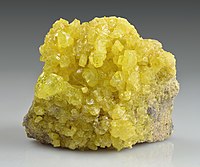
Photo from wikipedia
Cyanobacterial blooms in freshwaters represent serious global concerns for the ecosystem and human health. In this study, we found that one of the major species in cyanobacterial blooms, Microcystis aeruginosa,… Click to show full abstract
Cyanobacterial blooms in freshwaters represent serious global concerns for the ecosystem and human health. In this study, we found that one of the major species in cyanobacterial blooms, Microcystis aeruginosa, was quickly collapsed after exponential growth by producing self-bleaching compounds and that a symbiotic bacterium, Pseudomonas sp. ABSTRACT Various interactions between marine cyanobacteria and heterotrophic bacteria have been known, but the symbiotic relationships between Microcystis and heterotrophic bacteria remain unclear. An axenic M. aeruginosa culture (NIES-298) was quickly bleached after exponential growth, whereas a xenic M. aeruginosa culture (KW) showed a normal growth curve, suggesting that some symbiotic bacteria may delay this bleaching. The bleaching process of M. aeruginosa was distinguished from the phenomena of previously proposed chlorosis and programmed cell death in various characteristics. Bleached cultures of NIES-298 quickly bleached actively growing M. aeruginosa cultures, suggesting that M. aeruginosa itself produces bleach-causing compounds. Pseudomonas sp. MAE1-K delaying the bleaching of NIES-298 cultures was isolated from the KW culture. Bleached cultures of NIES-298 treated with strain MAE1-K lost their bleaching ability, suggesting that strain MAE1-K rescues M. aeruginosa from bleaching via inactivation of bleaching compounds. From Tn5 transposon mutant screening, a metZ mutant of strain MAE1-K (F-D3) unable to synthesize methionine, promoting the bleaching of NIES-298 cultures but capable of inactivating bleaching compounds, was obtained. The bleaching process of NIES-298 cultures was promoted with the coculture of mutant F-D3 and delayed by methionine supplementation, suggesting that the bleaching process of M. aeruginosa is promoted by methionine deficiency. IMPORTANCE Cyanobacterial blooms in freshwaters represent serious global concerns for the ecosystem and human health. In this study, we found that one of the major species in cyanobacterial blooms, Microcystis aeruginosa, was quickly collapsed after exponential growth by producing self-bleaching compounds and that a symbiotic bacterium, Pseudomonas sp. MAE1-K delayed the bleaching process via the inactivation of bleaching compounds. In addition, we found that a metZ mutant of strain MAE1-K (F-D3) causing methionine deficiency promoted the bleaching process of M. aeruginosa, suggesting that methionine deficiency may induce the production of bleaching compounds. These results will provide insights into the symbiotic relationships between M. aeruginosa and heterotrophic bacteria that will contribute to developing novel strategies to control cyanobacterial blooms.
Journal Title: Microbiology Spectrum
Year Published: 2022
Link to full text (if available)
Share on Social Media: Sign Up to like & get
recommendations!